If you want to know about the toilet design or cluster planning for housing or form in architecture, please click the link.
Ergonomic kitchen design refers to the arrangement and configuration of a kitchen space that takes into account the comfort and efficiency of the people who use it. It aims to reduce physical strain and improve the overall experience of cooking and food preparation.
- House is the most important place in a woman’s life where she nurtures and cares her family.
- Kitchen in the house is the platform where the feeding of family is done. So, an efficient kitchen design which is convenient to work in with minimum effort and maximum comfort will turn cooking from an unpleasant duty to a pleasant one.
- Let us see how kitchen can be designed ergonomically to make it work efficient, step saving and comfortable.
- Application of ergonomic principles / human factors can go a long way in making the kitchen efficient.
- This article will help the students to understand the importance of kitchen designing and will enable them to design spaces with ergonomic principles which will make them efficient kitchen designers/ entrepreneurs.
1) Objective
- Get awareness on the need for designing a kitchen efficiently.
- Identify the various aspects in kitchen designing.
- Study the influence of human factors in kitchen designing and enable them to establish the learner’s/ clients’ comfortable working levels in kitchen designing.
- Understand the ergonomic principles in space designing
- Develop ergonomically viable kitchen designs.
2) Kitchen – importance, Activities in kitchen
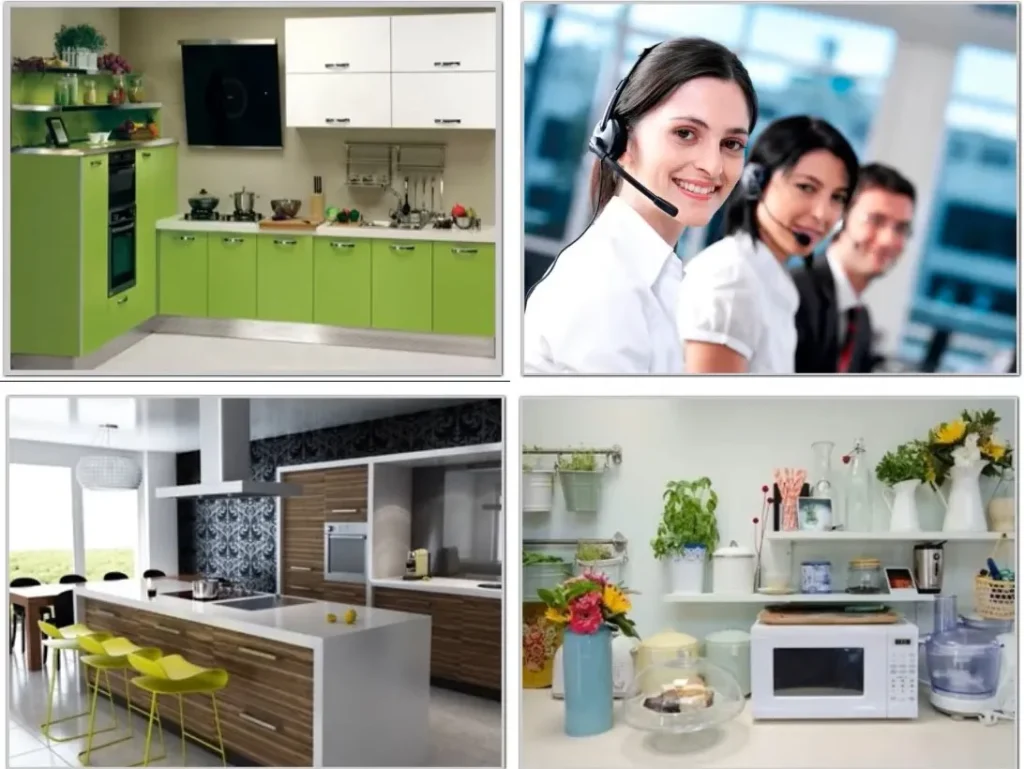
- Kitchen, the citadel of civilization is the foundation on which the home builds up. Kitchen plays a very important place in a woman’s family life and studies show that women spend 4-6 hours per day in an Indian household.
- In a house, kitchen is the major work centre. Majority of the women are employed and there is a high pressure on time and energy. So, a well-organized kitchen with good facilities can help the homemakers to make their kitchen work interesting and time saving.
- Modern kitchen is very different from traditional kitchen.

- With the advent of science and technology, many new equipment’s and appliances which are work efficient and aesthetically designed have adorned the modern kitchen. Kitchen is in a state of revolution with continuous workspaces, fitted storage for labour saving equipment’s like mixers, grinders, ovens, and work centres for standing and cooking and serving and also modern floor and wall finishes which made the kitchen the most beautiful room of the house.
- Modular kitchen has become popular, and they are ready made kitchen units which are complete in every detail with counter tops, storage cabinets (wall and floor), racks and shelves, sink, hob, chimney and sometimes with refrigerator, garbage disposer, dishwasher and water purifier as per the customer demands.
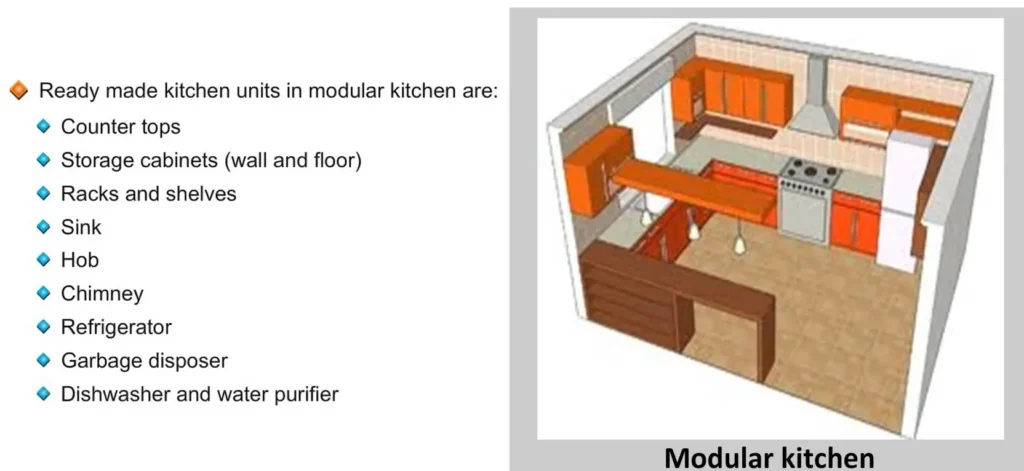
- This concept of designing modular units with human body dimensions were introduced by the famous designer, Le Corbusier is the basis for modular kitchen designs. There are two options for this- (1) carpenter made and (2) factory made.
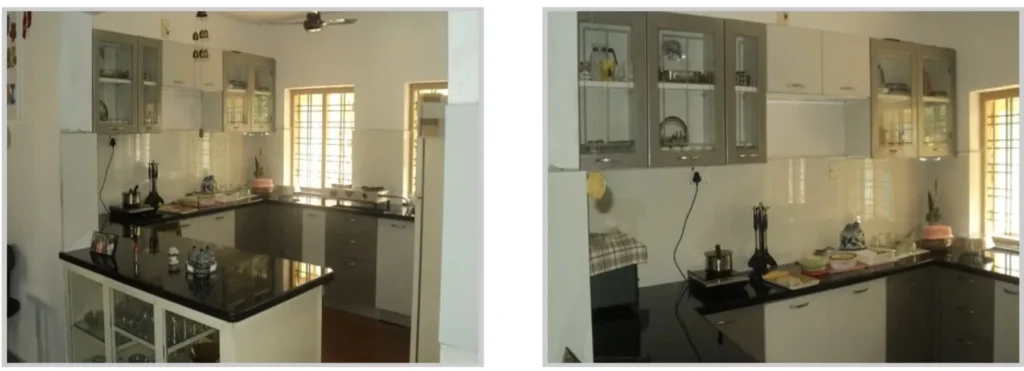
- Factory made can be imported or localized as Companies like Sleek kitchen and Godrej in India are manufacturing the modular kitchen units as per the colour and style demanded by the customers.
3) Types of Kitchen
- There are different styles of kitchen and can be classified according to the shape of arrangement of the stove (cooking centre), sink (washing area), and work surface (preparation area) and refrigerator.
| Sr. No. | Types of Kitchen | Image | Description |
| i) | L Shape/ broken L or right angle | 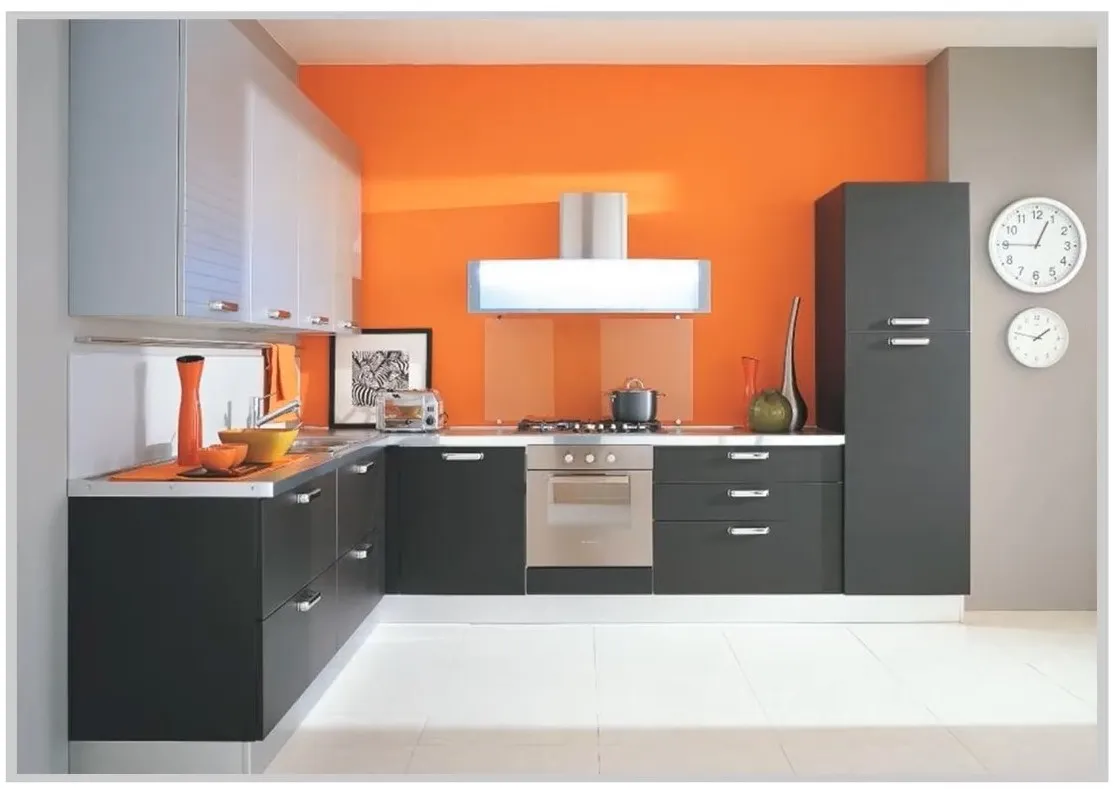 | Work centres arranged in L shaped pattern. If there is any equipment or door in between the L shape, it is called as Broken L. Considered as very practical plan with less distance between centres and leaves room for eating or laundry and diverts traffic when need arise. |
| ii) | U Shape/ Broken U Kitchen |  | Three major centers such as Refrigerator, sink(washing ) and stove( cooking) arranged in a ’U’ pattern. Most compact, efficient and ideal arrangement for work performance with minimum traffic. |
| iii) | Corridor/ double wall/ galley/ opposite wall | 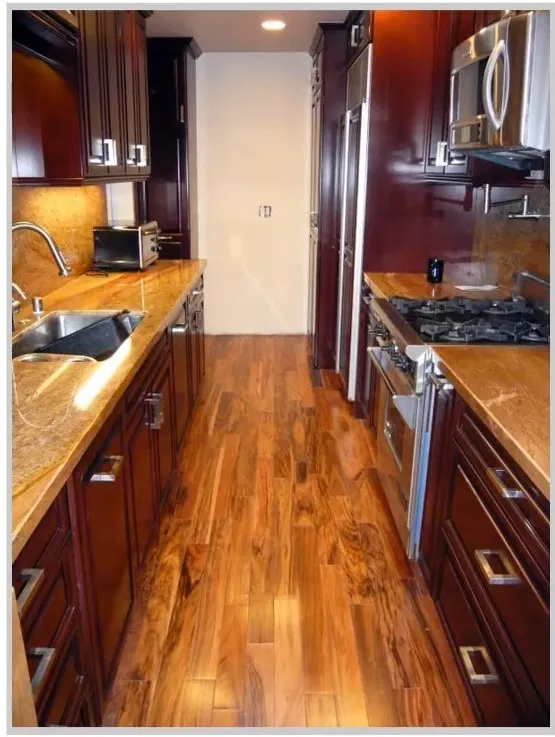 | This style further reduces distance s between work centres but invites traffic if doors are located at both ends |
| iv) | One wall/ straight line/ single line kitchen | 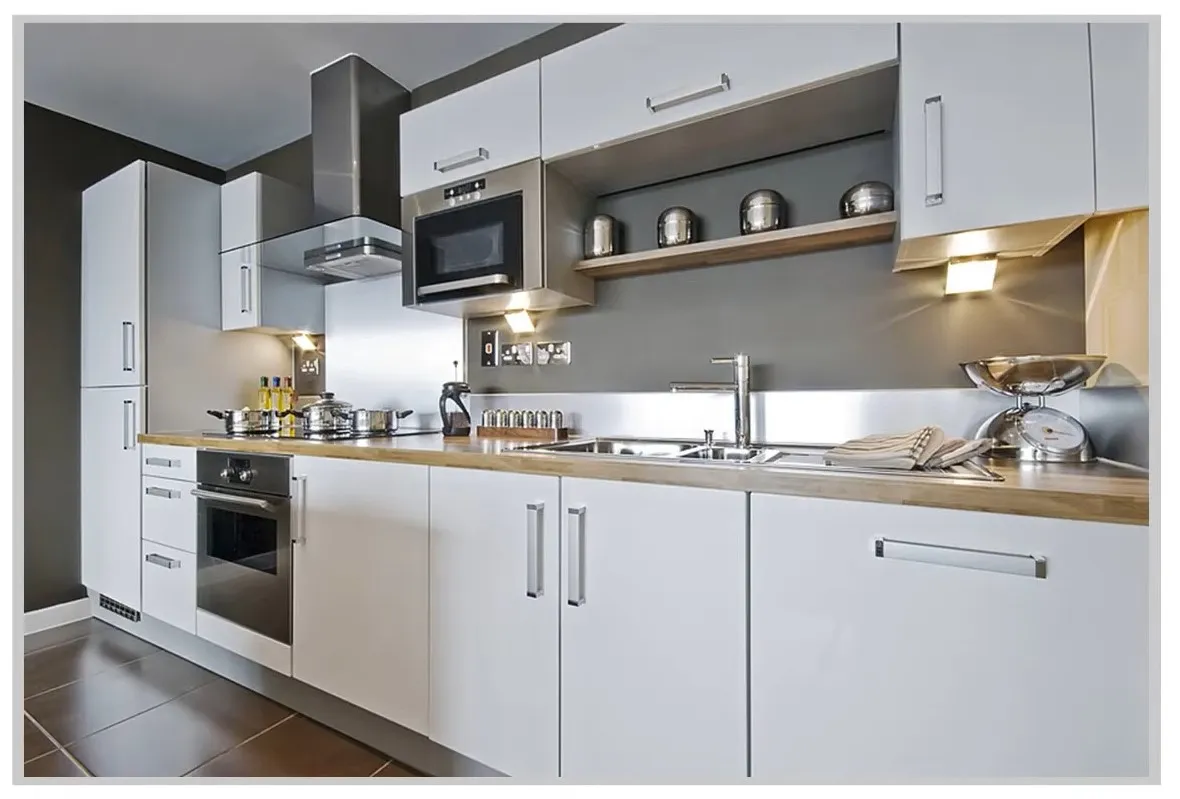 | Arrangement of work centres limit itself to one wall and can be fitted into alcoves and concealed when not in use. It is the least efficient due to insufficiency of space |
| v) | Island Kitchen | 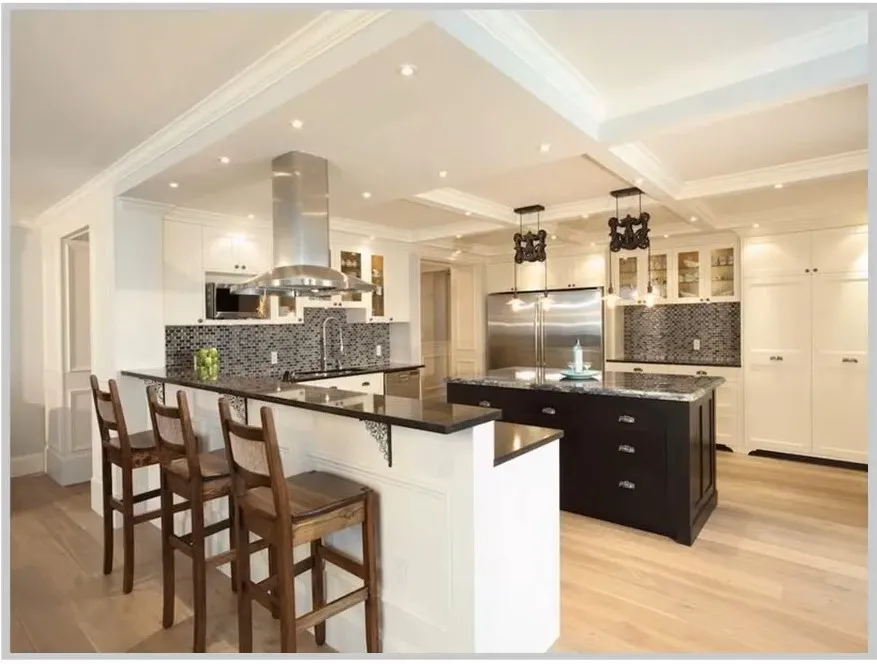 | The main feature of this kitchen is that one of the centre of the work triangle will be in the middle of the room. Island unit is a convenience both for the diner and the cook with extension of kitchen counter where cooking and dining are combined in one space which is suitable only for large kitchen. |
| vi) | Peninsular kitchen | 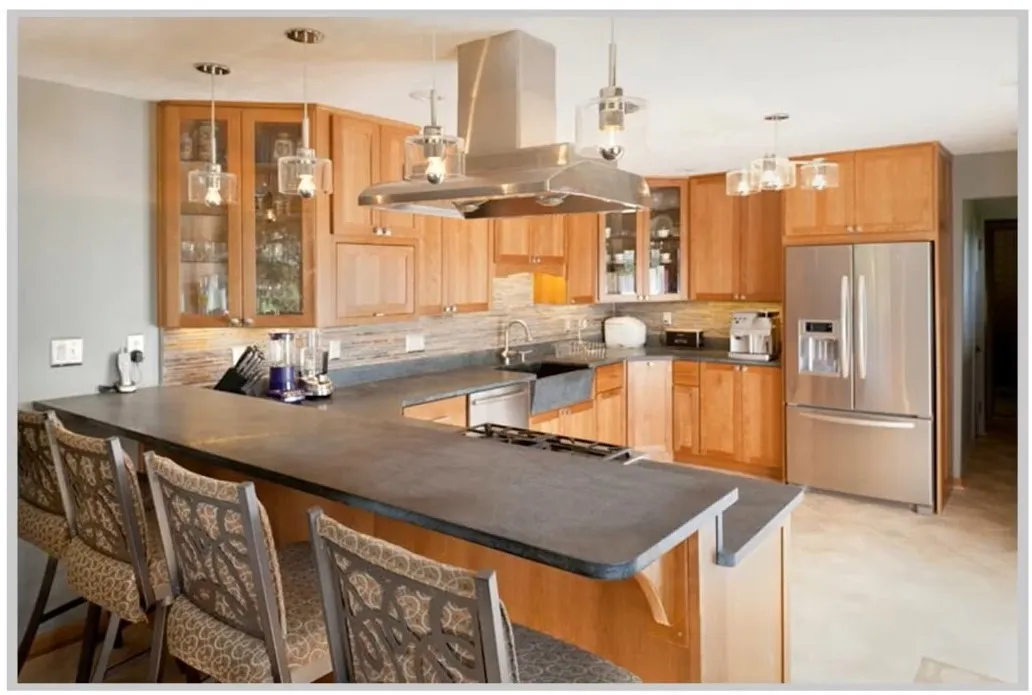 | This will have a unit free on three sides with the other wall perpendicular to the wall or other work centres. The independent side can be utilized as a dining space or a study area for small children and mother can monitor them. |
4) Why kitchen design is important?

- Kitchen being the major work centre in a house, women need to be busy throughout by cooking, serving, cleaning and washing the utensils etc. Work will become tedious in case of employed home makers especially in the morning. Present day kitchen should be designed in such a way that it suits the taste of the homemaker, and she should be proud to work in her kitchen and the kitchen should work for her.
- Kitchen is a specialized work room where activities like preparation of meals, food and utensils storage, serving, cleaning and sometimes even laundering, entertaining and child care are also taken care of.
- But we don’t know how far the homemakers are comfortable in their kitchen. Studies reveal that, they are having discomforts such as:
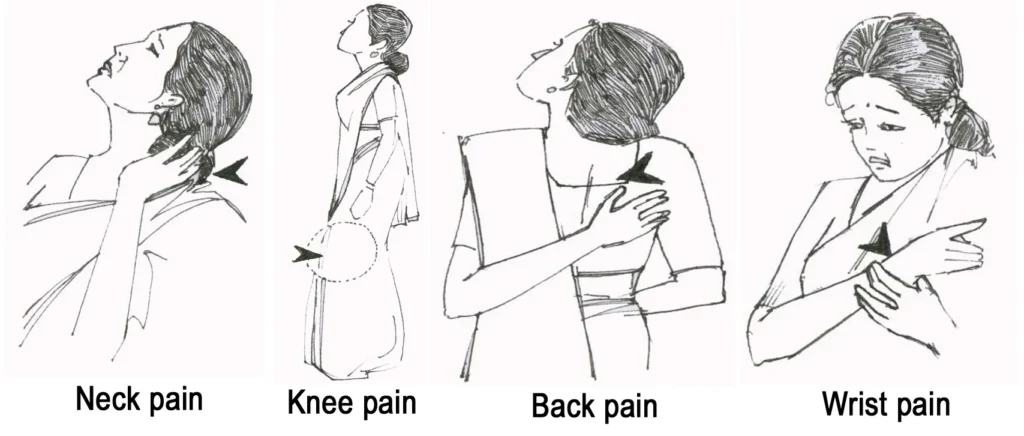
- The pain in the shoulders, back and arms are felt while continuously stirring or frying the food items which are common in Indian recipes which is very elaborate or while washing utensils in a sink which is not positioned properly. These symptoms are due to the constant strain on muscles due to the inconvenient working heights and reach.

- Working height is of critical importance in the design of workplaces. For high work surfaces, the shoulders must frequently be lifted up to compensate leading to painful cramps at the level of shoulder blades, neck and shoulders. Low work surfaces cause a person to stoop, a position which lays stress on the back muscles.
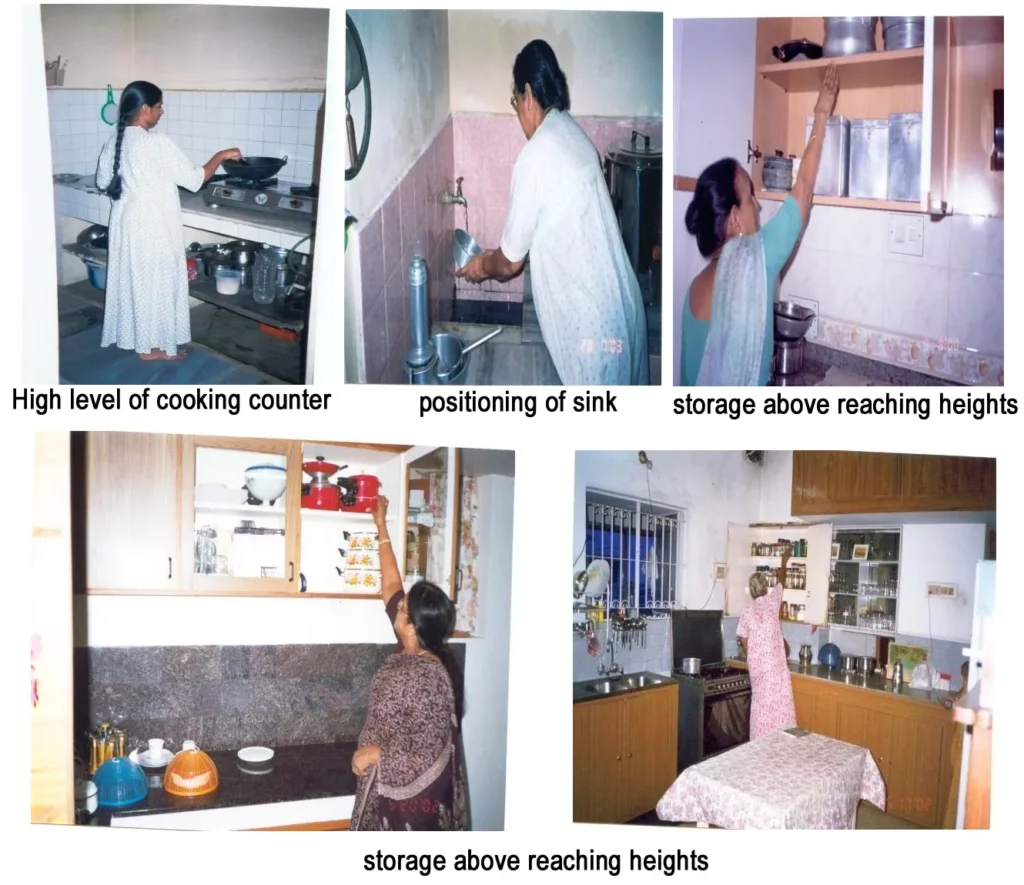
- Though, these kitchens are having modern facilities, it is clear that they are not designed to suit the home makers’ convenient working heights.
5) Ergonomics – Meaning, and importance
- Ergonomics is about designing for the people who work or wherever they interact with products, system or processes. If applied, it ensures that, designs complement the strength and abilities of people and minimize the effects of their limitations rather than forcing them to adapt.

- Application of ergonomics will make the product easy to handle, efficient to manufacture, comfortable and safe to use and make it fit for the purpose for which it is made.

- It refers to the study of work laws which result in efficient adaptation of work methods to the individual’s physiological and psychological qualities for better safety, health and efficiency.
Ergonomics in workplace includes:
| Sr. No. | Components | Aspects |
| i) | Layout/ design of work place | Sequence of arrangement, shape of layout and work triangle. |
| ii) | Placement and storage of equipment | Wall and floor storage cabinets and shelves as per anthropometric measurements and postural habits of home makers. |
| iii) | Environment | Lighting, temperature and noise Visual environment- colour and accessories |
Principle of ergonomics is the relationship between the work, worker and work environment Components – Anthropometrics, Posture maintenance and space standards
i) Ergonomics in kitchen means
- Work – preparation, cooking, washing, storage ,serving etc
- Worker – Height, elbow level, comfortable reaching levels (horizontal and vertical) of home maker or Anthropometrics
- Work environment – style of kitchen, sequence of work centre arrangements and work triangle and colour scheme and equipments
ii) Work centre arrangements
- Kitchen designs means arrangement of work centres, their positions and its horizontal and vertical reaching levels.
| Sr. No. | Work centres | Activities involved | Equipments |
| i) | Preparation centre | Storage of equipments& utensils Provisions and vegetables | Storage cabinets, shelves and racks. Refrigerator |
| i) | Preparation centre | Cutting vegetables, mixing and grinding, Kneading etc. | Mixer, juicer, cutting board etc. |
| ii) | Cooking centre | Cooking – frying, making chappathis, boiling, stirring etc | Cooking stove, electric induction cooker Pressure cooker, tawa, frying pans etc. |
| iii) | Washing centre | Washing vegetables, utensils and serving dishes | Sink, & draining board |
6) Work sequence and Work triangle
- Arrangement of work centres in the kitchen should be flexible, but at the same time, the flow of arrangement should be in a logical progression like, from refrigerator to preparation centre and then to cooking centre and then to sink.
- The path connecting refrigerator, stove and sink results in work triangle and the total distance should not be less than 3m (10ft) and not more than 8m (25ft.).
- The distance between these three areas should be minimum, at the same time we have to maintain the space standards ie. there should be sufficient clearance space.
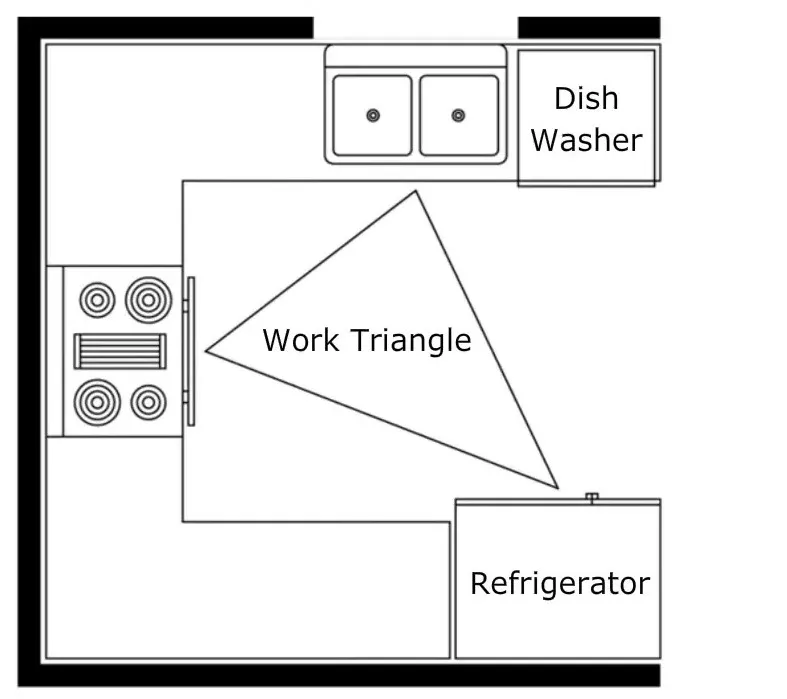
i) Preparation centre
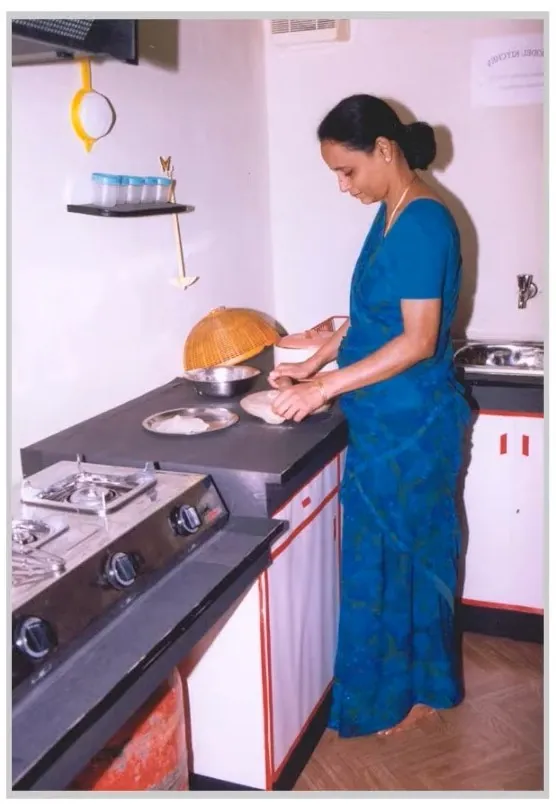
- Activities done in this area include cutting, chopping, mixing, kneading, beating, spreading grinding and other related activities.
- Grey (1997) opines that to ensure enjoyable cooking, preparation area needs ample space, a hard-wearing work top and the suitable storage of food provisions and equipment close at hand. A refrigerator adds to the convenience of preparation centre.
ii) Cooking centre

- It is where actual cooking, boiling, frying, stewing, sautéing etc. with the help of fuel (Gas stove, electric induction cooker, Electric/gas oven etc.) takes place. A location near the sink, preparation and serving centers is desirable.
iii) Washing or sink centre
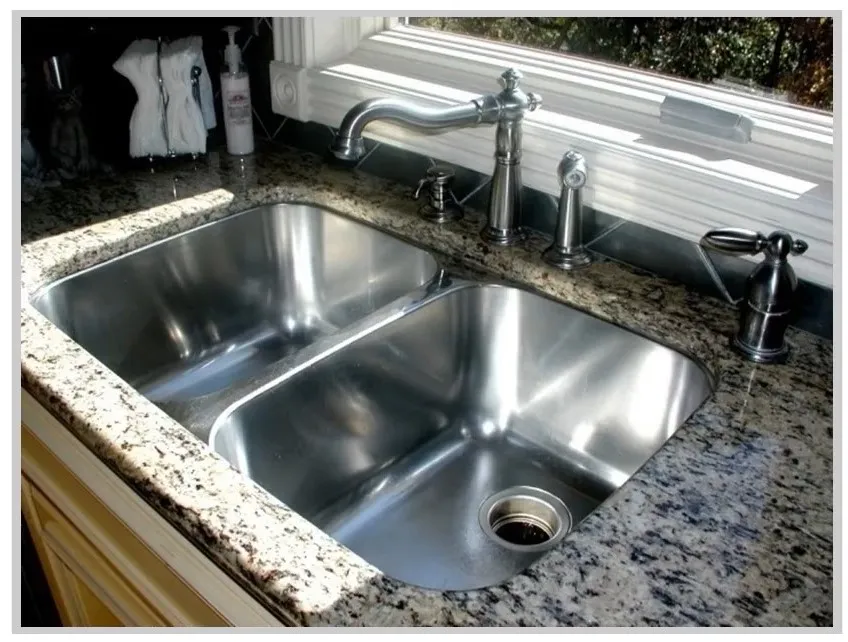
- This is the most used part of a kitchen and makes a positive contribution to the look and feel of a kitchen.
- Best position will be between preparation and cooking centres and should be fixed near the window so that sink will receive natural light during daytime.
- Its requisites are, regular supply of running water, storage space for used and washed dishes, space for trash and garbage disposal, ample counters on either side of sink, space for cleaning utensils and straining food items.
- A space for soap and detergents, scrubbers, brushes etc. should be an integral part.
7) Worker – Anthropometrics

- Physical comfort of people who do the cooking and clean up, way in which each work centre is arranged, contribute to the speed, efficiency and the physical effort involved.
- Postural habit is very important in planning a kitchen; otherwise, the inefficient design may cause degenerative changes in the body through poor posture which result in all types of discomforts.
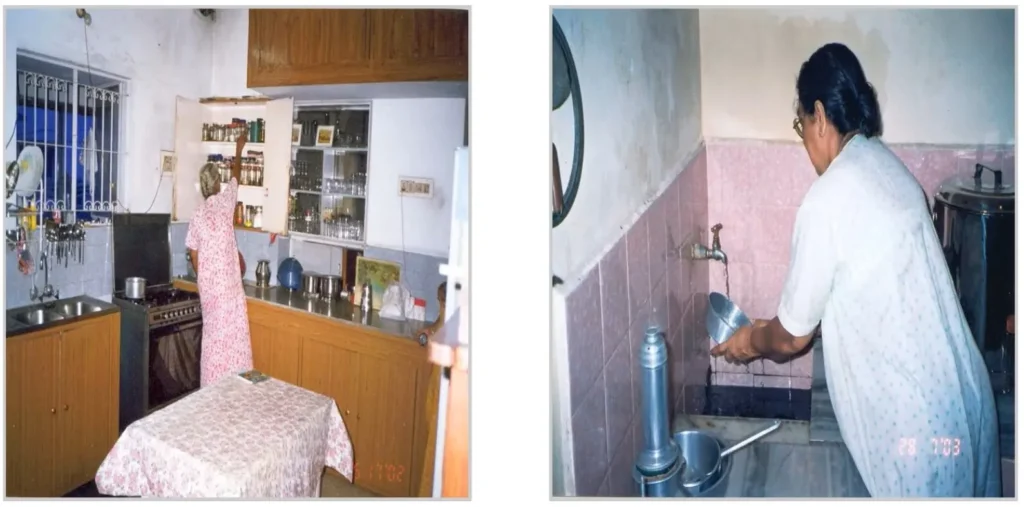
- Home maker has to maintain a posture which allows functioning effectively with minimum energy expenditure and minimum strain. Standing posture helps to simplify the job and results in reduced drudgery. Knowledge and application of Ergonomic principles in kitchen designs can achieve an optimal relationship between the work, worker and work environment.
- Ergonomics/Human factors engineering involve Posture and Anthropometric measurements of the homemaker. Anthropometric measurements are concerned with measurements of human body from specified anatomical points and anatomical measurements of women having different heights, help in establishing the maximum and minimum levels of working planes and designing work areas at vertical and horizontal surfaces. But use of these anthropometric measurements has not yet percolated while designing kitchen in the Indian households.
- According to WHO expert committee (1995), anthropometric indices are combinations of measurements which are essentials for the interpretation of other measurements.
- Use of body dimensions such as height, elbow level, and hand reach can be utilized in planning ergonomic layouts, in evaluating area specifications and in designing work surface heights, reach dimensions and zones of comfortable reach maintaining correct posture at work. Anthropometric measurements help to arrange functional design where facilities fit people. (Ray et.al 1990 and Ardley ,1990)
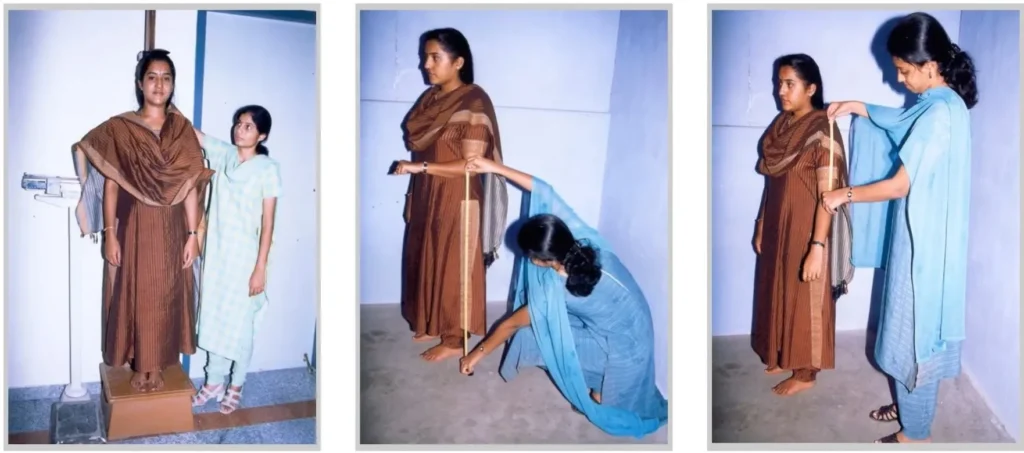
- In order to determine the comfortable reach, general body measurements like height, elbow level and arm length can be taken as the basis for determining the dimensions of the work centres.
- For determining the working heights, and the width and depth of work surfaces, reaching heights in the vertical plane and reaching length in the horizontal plane of home makers respectively need to be taken.
- Reaching heights in the vertical plane includes normal comfortable reach, Maximum reach and minimum reach.
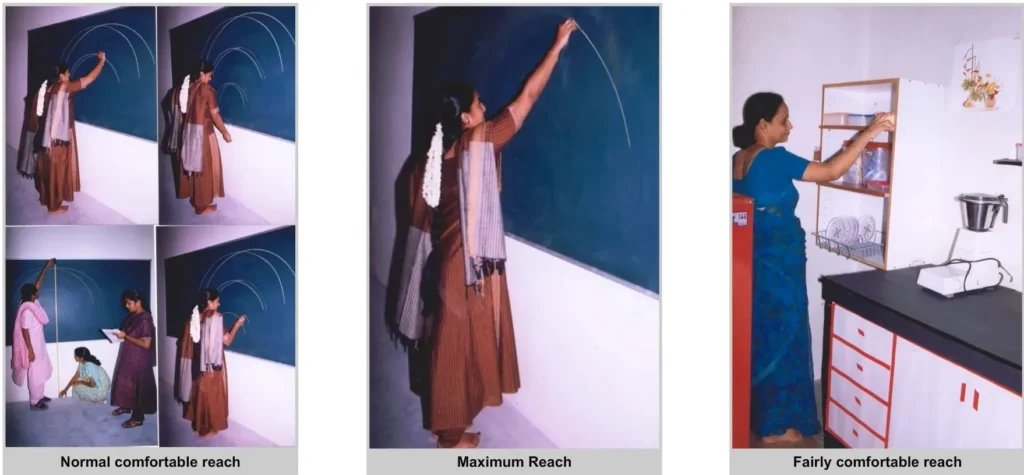
- Normal comfortable reach is determined by the sweep of hands with the fore arms extended when the upper arms hanging at the side of the body in a natural position. The upper arms move away slightly at the completion of drawing the arc. When the arcs drawn by the left and right hand intersect each other in front of the worker and that point is the place of convenient reach.
- Maximum Reach: Arcs are drawn with the upper arm extended fully from the shoulder and not hanging (one hand at a time). The overlapping point of arcs of both hands indicates the maximum reaching height.
- Minimum reaching height is determined by keeping the upper arm close to the hip level and inverted arcs are drawn by both the hands one at a time. This determines reaching heights beneath the counter levels or the lower section of the shelves.
- Fairly comfortable reach: This could be earmarked between normal and maximum reach with upper arm raised to be parallel to floor and arcs drawn in a similar manner. This will determine the level to store various utensils and the type of built in storage shelves found in Indian households.
- Reaching length in the horizontal plane include normal comfortable reach and maximum reach which can be done in front of a table in a standing posture. This determines the width of the counters.
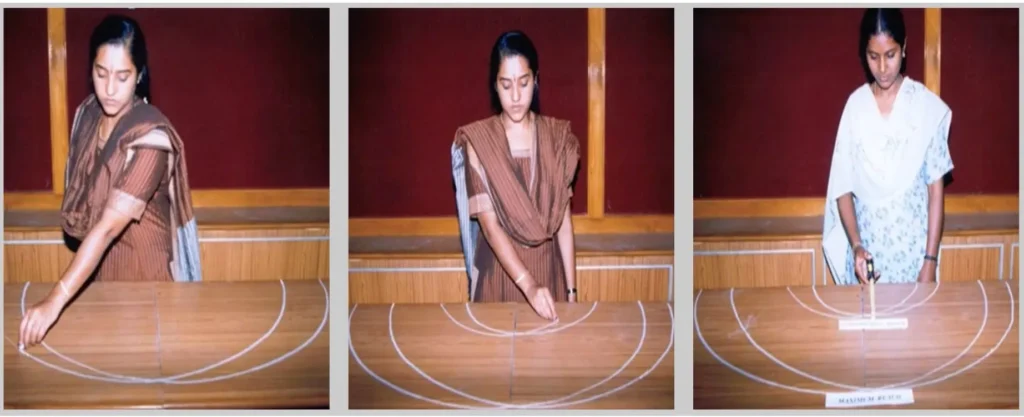
- Normal comfortable reach can be determined by drawing the arcs with the fore arms extended and the upper arms hanging at the side of the body in a natural position. The overlapping section of arcs is the area in which work may be done more conveniently.
- Maximum reach: arcs are drawn with the arms extended and stretched fully from the shoulder form the maximum working areas. This area indicates the distance beyond which work cannot be done without disturbing the posture.
i) Work surface heights
- As opined by Gilbreth et.al (1975) home maker should stand with her arms comfortably relaxed from the shoulders without stooping and need not have to raise her hands above elbow level. Study conducted by Rymala, (2004) reveals the following measurements for kitchen work centres.
- Preparation centre: for a lady with an average height of 156 cm, it was shown that 84.3 cm which is 15.6 cm lower than your elbow level.
- Cooking centre: It is shown that the convenient work surface height for cooking can be 73 cm for a lady with 156cm which is 27 cm lower than her elbow level.
- Height of the elbow is an important landmark for determining the desirable work surface.
- In India, 76cm or 30 inches (2.5ft) above the finished floor level is considered as the general uniform height for the kitchen counters, though separate counter height for cooking is not mentioned.
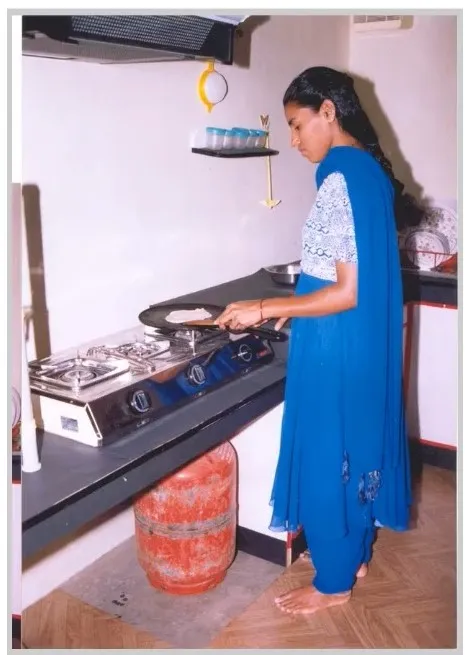
- While determining the cooking counter height, height of the stove, utensils (pressure cooker or Tawa) also should be considered. This shows that, cooking counter should be 10-12 cm lower than the rest of the kitchen counters for ease of cooking.
- Washing centre: The height and width of washing centre and preparation counter can be same, (84.3 cm height and width53 cm) with a slope of 2cm slope at the sink edge will help in draining of water.
- As per the CPWD specifications, 80 cm is the preferable height of kitchen sink, fixed above the finished floor level and the width of inner side is 45cm. the length of the bowl may be 50 cm. The positioning of tap is very important. The height of tap (water outlet) from the counter was 22.4 cm which allowed a mean space of 47.4 cm between the sink bowl floor and the tap allowing adequate space for washing of utensils used for cooking.
- Similarly a distance of 33cm from the from the counter edge was found to be convenient for the tap position avoiding strain to reach the tap if fixed very close to the wall on a counter width of 53cm. Individual differences can be there but not much significant differences and hence this can be used as a basis for ladies with average height of 152-160 cm.
- Kitchen Environment: A comfortable working kitchen environment for the homemaker should have good lighting and ventilation, availability of good water and drainage facilities and accessories required.
- Lighting and ventilation: General and task lighting near the stove, sink and dining area. Ventilation should include, ventilators below the ceiling, one or two windows, chimney, electric fan, and an exhaust fan.
- Water and drainage facilities: Direct tap connection to kitchen, facility to stop water, Water purifier and adjustable or movable water tap. Drainage through open drain, to municipal drain, soak pit and kitchen garden. Accessories: Chair or stool for rest, radio or music system for relaxation or view of TV from the kitchen, a wall clock, calendar, emergency lamp, and aesthetic accessories like paintings or wall hangers flower arrangements, indoor plants or other curios help in creating a good interior environment.
8) Conclusion
- Kitchen being the microcosm of the whole house, there is a growing enthusiasm to have a modern kitchen for all home makers.
- Ergonomic approach will enable the homemaker to decide over a design to suit her profile for increased comfort and convenience. Less strain, no pain, less time and energy are the benefits of a well designed kitchen.
- These resources can be utilized for employment, or creative work or health boosting activities like gym, and quality time with family members especially children.
- Though considerable progress is found in the kitchen design and style of arrangement, application of ergonomic principles will help us to have a modern and healthy kitchen which will give a dignity to the household work at the same time to the homemaker working in it.
By incorporating these elements into a kitchen design, you can create a space that is both functional and comfortable to use.